
How do Pokémon Go Influencers construct their authenticity on Instagram?
How do social media influencers construct authenticity on socio-technological platforms such as Instagram? In this article, instead of utilizing the common formulation of authenticity as being true to oneself through inward-outward dialogues, following Grande (2019), I will bring attention to an alternative conception of authenticity based on Heidegger, using Pokémon Go influencers- the Trainer Club and Trainer Tips, as case studies.
Social media influencers and authenticity
With the growth of socio-technological platforms such as Facebook and Instagram, we see the emergence of social media influence. Abidin (2015) admits that social media influencers operate in a specific field, e.g., fitness, and gaming, among others. They distribute textual and visual content of their personal lives on socio-technological platforms. Influencers possess considerable characteristics following on these platforms, and they often engage with their followers and integrate “advertorials” into their contents. They follow the logic of what Senft described as “micro-celebrities,” who are individuals that make use of online performances across mediums such as videos, blogs and social networking sites to “amp up” their popularity over the internet (2008, p.25). Studies and discussions on social media influencers and influencer marketing have commonly been connected with the concept of authenticity, as several studies have shown that the success of an influencer's brand is positively related to whether they are being perceived as “authentic” by their followers (Bruns, 2018; Glucksman, 2017; Pöyry, Pelkonen, Naumanen, & Laaksonen, 2019).
Pokémon Go
Pokémon Go is a location-based augmented reality mobile game jointly developed by Niantic, The Pokémon Company, and Nintendo. Made possible by the application’s utilization of AR technology and built-in GPS services on our mobile devices, players can spot and catch various species of Satoshi Tajiri’s famed creatures within their vicinity. Since its release in 2016, Pokémon Go has been one of the most successful mobile applications worldwide, surpassing one billion cumulative downloads in 2019 (Winslow, 2019).
Authenticity
The concept of authenticity has been a contested field in academia. Early studies on authenticity in the online/offline world mostly drew upon a definition of authenticity similar to what Charles Taylor discussed in his 1991 book, The Ethics of Authenticity. Taylor defines authenticity as being true to oneself; that the search for an authentic self is situated in one’s “inner depth,” where “the individual can come in contact with what one really is” upon reflective introspection, he/she then proceed to “express himself to the world in his own unique and proper mode” (Abdilla, p.1). However, as scholars of authenticity have critiqued, such conception would eventually lead to an inauthentic/authentic dichotomy between the online/offline world, where the former was being perceived as “fake” and the latter as more “real” and “authentic” (Reade, 2020, p. 3).
With the emergence of social media comes another wave of theorists that view authenticity “not as an inherent quality, but rather part of a ‘performative ecology’” (Abidin, 2018, cited in Reade, 2020). This performative understanding of authenticity mostly manifests as utilizing certain strategies on socio-technological platforms, e.g., the sharing of intimate/personal stories or the conscious choice to leave particular pictures of themselves unedited so as to appear more “real” to others.
More importantly, these performative actions, as described by Marwick and boyd (2010), are parts of an “ongoing front-stage identity performance” which stems from reciprocal dialogues regarding individuals' authenticity between them and their (imagined) audience. In other words, authenticity is considered as a “communicative process” that is “enacted through negotiations between producers of content and audience members” (Enli, 2015, cited in Reade).
Authenticity reconceptualised (Grande,2019)
While previous studies have yielded fruitful explorations on authenticity, Grande (2019) has offered critiques on the two conceptions of authenticity in his work. He argues that the notion of authenticity is one’s “essentialistic features," and that to be authentic entails being true to oneself, inevitably becomes “rather circular and tautological," that is, “when you are true to yourself, you are authentic, and when you are authentic, you are true to yourself." Furthermore, studies drawing on such a definition, as previously mentioned, have been limited to a rather superficial authentic/inauthentic dichotomy on the basis of which researchers merely suggest how to be (more) authentic. The suggestions would often return its repetitious definition “in order to be authentic, you must be true to yourself." The idea of authenticity as a “localized, temporally situated social construct that varies widely based on community” (Marwick & boyd, 2010, p. 124), seemed to become a “freely floating concept” that fail to illustrate how authenticity is actually constructed (Grande, 2019, p.8).
Alternatively, in his study on fitness bloggers on Instagram and their construction of authenticity, Grande (2019) drew upon Heidegger’s conception of authenticity, where instead of formulating authenticity as being one’s true self on the basis of a set of opinions, feelings, or desires “consulted through inward turning and introspection” (Varga & Guignon, 2020). Heidegger grounded the concept of authenticity as a way of being in the world. More precisely, for the philosopher, an individual's authenticity stems from “standing up for and standing behind what one does—as owning and owning up to one’s deeds as an agent in the world.” In this sense, the “true self” becomes an “ongoing narrative construction: the composition of one’s own autobiography through one’s concrete ways of acting over the course of a life as a whole” (Varga & Guignon, 2020).
Within the context of Instagram influencers then, their authenticity would be the “overall composition of their ‘being’ on Instagram,"i.e., the way that they merge socio-cultural norms within a promoted field and their knowledge outside such field to construct a coherent semi-autobiographical narrative (Grande, 2019, p.63).
Grande's Results (2019)
Drawing on this understanding of authenticity, Grande utilized a combination of Foucauldian and Bourdieusian frameworks, both of which have been influenced by Heidegger’s notion of authenticity (Dreyfus, 2008; Bourdieu, 1991, cited in Grande, 2019). Central to Grande’s research is the Bourdieusian theory of capital. Expanding on the economic concept of capital, Bourdieu (1986) calls attention to the different forms of accumulated labor which can be “appropriated on an exclusive basis by agents or groups of agents” so as to reproduce or maintain their position in a social field. Heidentifies three forms of capital (1986, pp.241-258):
Economic capital entails the accumulation of resources that are immediately and directly convertible into money such as property rights. Cultural capital entails the accumulation of knowledge and skills that are relevant in a given field. It may manifest in the embodied state as an individual’s acquired knowledge, cultural preferences, and behaviors; in the objectified state as “cultural goods” to be consumed by individuals such as books and paintings; in the institutionalized state as educational qualifications. Social capital entails the accumulation of “a durable network of relationships of mutual acquaintance and recognition”, i.e., memberships to social groups such as families, tribes, or political parties; it provides individuals’ credentials that can be utilized to advance their interests.
For Bourdieu (1986), these different forms of accumulated labor are not only transmissible, e.g., one can inherit properties from his/her family members, but mutually convertible. For example, one’s academic qualification (cultural capital) can be converted into economic capital, as such qualifications hold particular “monetary values for which it can be exchanged on the labor market.”
With the framework established, Grande (2019) utilizes a qualitative multiple case study approach to his investigation on fitness bloggers on Instagram. He focused on 20 Instagrams posts by three fitness bloggers with approximately 80 thousand, 306 thousand, and 5 million followers respectively. Data is analyzed through a combination of Bourdieusian field analysis and Foucauldian discourse analysis. The former seeks to examine the overall construction of the field of fitness bloggers through operationalizing Bourdieu’s concepts; the latter uncovers the implicit and explicit relations of power present in the bloggers’ Instagrams posts.
Overall, Grande suggested that there are four arguments that could be made in regard to the creation of influencers’ authenticity (2019, pp.60-61):
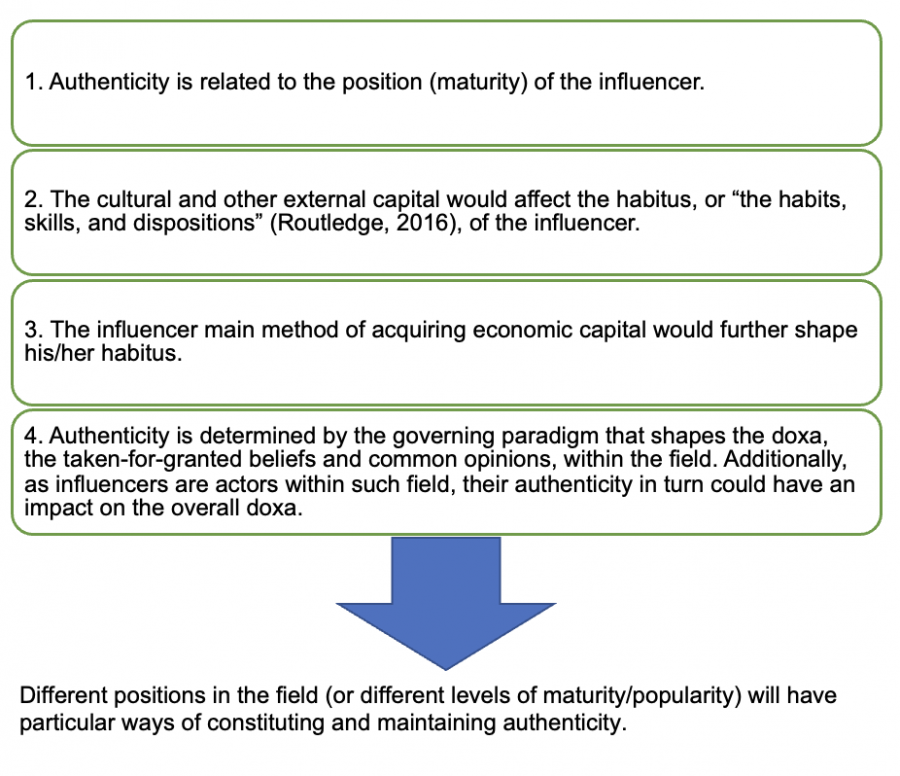
Grande's findings (2019, pp.60-61).
Pokémon Go influencers and their authenticity on Instagram
With that established, we begin our examination of how Pokémon Go’s influencers construct their authenticity on Instagram. First and foremost, I will classify the Instagram posts of Pokémon Go influencers into two categories, i.e., the posts related to the game or the Pokémon franchise and the posts about their personal lives. This is done in an effort to better compare and contrast their overall composition of their being on Instagram. The two influencers of attention are:
The Trainer Club, who, as of 22 January 2022, had approximately 30 thousand followers on Instagram and 290 thousand subscribers on YouTube. It is representing Pokémon Go influencers that are of low-tier popularity in this article.
Trainer Tips, who, as of 22 January 2022, had approximately 100 thousand followers on Instagram and 960 thousand subscribers on YouTube. It is representing Pokémon Go influencers that are of high-tier popularity in this article.
The Trainer Club
The Trainer Club started as a brand in April, 2018. The aim of the brand has been to help players become “the best trainers they can be."
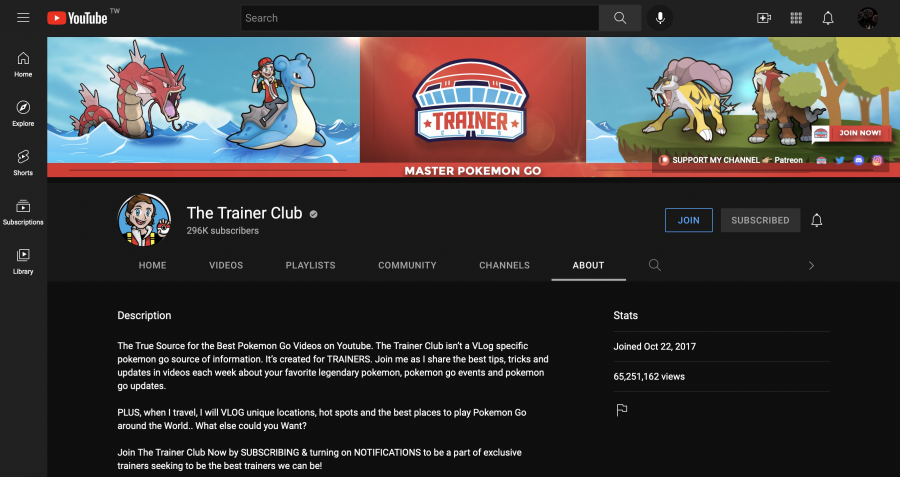
The Trainer Club’s YouTube channel description.
In the first category of posts (posts related to the game or the Pokémon franchise), it is interesting to note that there are a substantial number of posts that very much reflect such goal of becoming the best player in Pokémon Go. Namely, they are oriented towards providing detailed in-game information on which individuals could capitalize. Case in point, let us turn to this post published on 20 September, 2020.
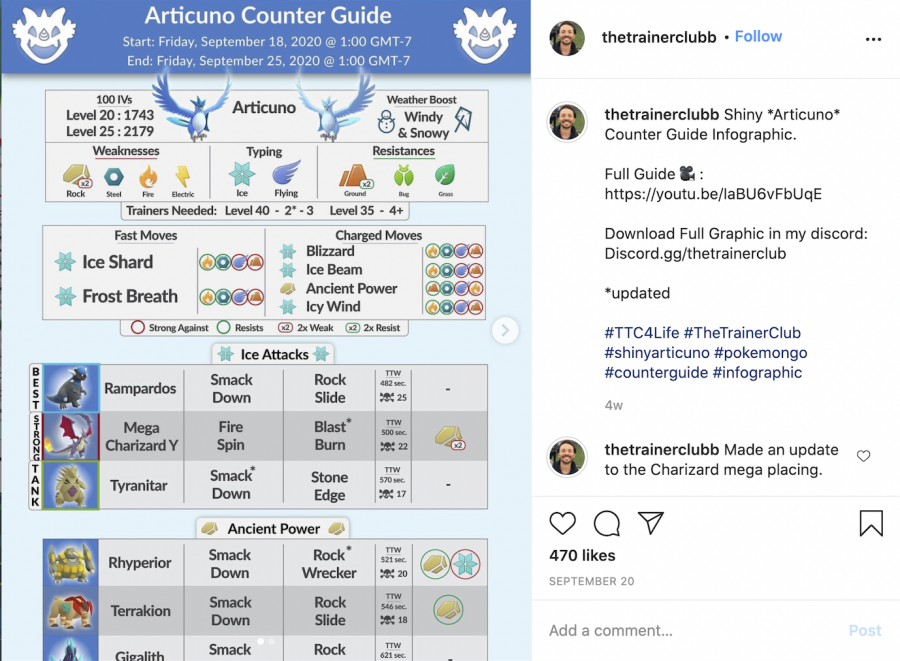
The Trainer Club’s Instagram post on 20/9/2020
Here, the Trainer Club included an “infographic,” containing information on how to take down Articuno, one of the legendary Pokémons that can be obtained through "raids" from 18 September, 2020 to 25 September, 2020 (as detailed on the very top of the graph).
To explain, raids are one of the collaborative endgame activities in Pokémon Go. While raiding, each player is allowed to use six of their caught Pokémon in a collective effort to tame the creature.

Articuno's weaknesses, typings, and resistances (The Trainer Club, 2020).
It is important to note that each Pokémon has a (combination of) typing. For instance, Articuno's typing would be Flying and Ice. These typings attributed to particular Pokémon could be "weak" or "resistant" to other typings. As in the case of Articuno, it would be weak against Rock, Steel, Fire, and Electric and resistant to Ground, Bug, and Grass (see screenshot below). Using Pokémon with moves that the raid bosses are weak to is of great importance, since, in raids, players must defeat the raided Pokémon within a certain time limit (see screenshot below).
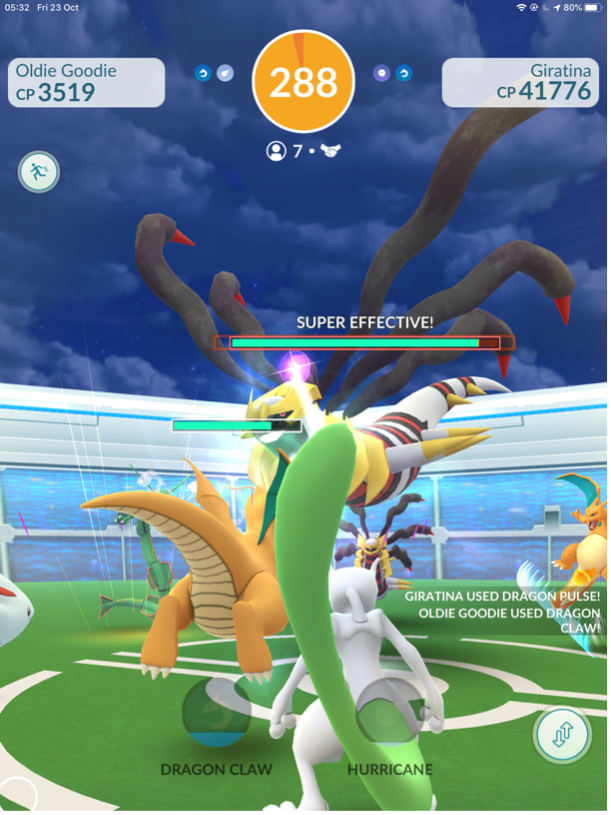
Raids in Pokémon Go.
Such posts are typical of The Trainer Club’s Instagram composition, as an infograph like this is posted each time a new Pokémon is introduced in raids (see screenshot below).
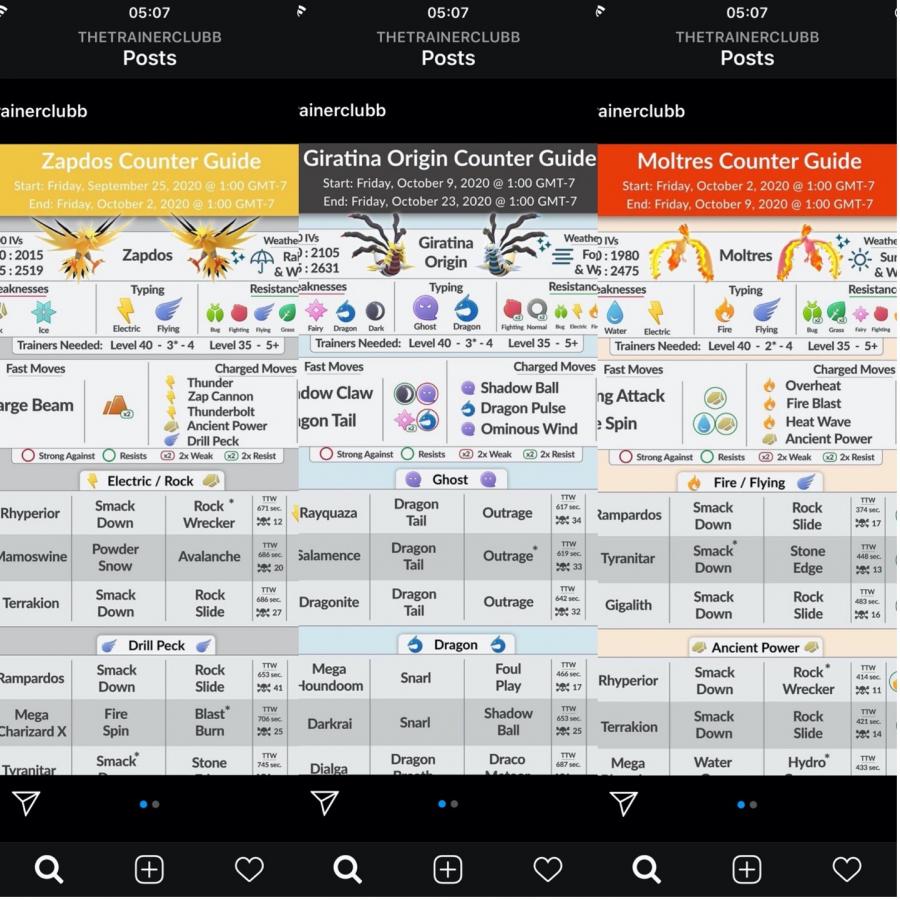
The Trainer Club’s raid Infographic for Legendary Pokémons.
As one can observe, these posts are very much in line with the stated objective of the brand, that is, to assist Pokémon Go players in their efforts to become the very best. Moreover, the posts could be seen as indications of the influencers’ adherence to the field of gaming, in which the common conception is arguably grounded within the gamers’ desire to become better at what they are playing. In other words, it could be contended that through the informative posts, the Trainer Club is utilizing his cultural capital, i.e., considerable knowledge about Pokémon Go, to further gain social capital, or more followers, which would in turn lead to more economic capital. Namely, as the base of followers for his brand grows, so the possibility of getting noticed by agencies that connect advertisers to influencers increases (Woods, 2016). Additionally, the growth of his followership base would entail not only more traffic for his posts on Instagram, but potentially lead to more engagement with the content uploaded on its YouTube channel, which in turn result in an increase in advertising revenues, paid exclusive memberships, and sold brand merchandises (Perelli, 2022; YouTube Help, n.d.).
Aside from posts providing useful information regarding how to maximize players’ experience when playing Pokémon Go, there is another form of posts that fall under the category of posts related to the game or the Pokémon franchise. These are the posts that included photos that were taken via the Augmented Reality (AR) feature in Pokémon Go.
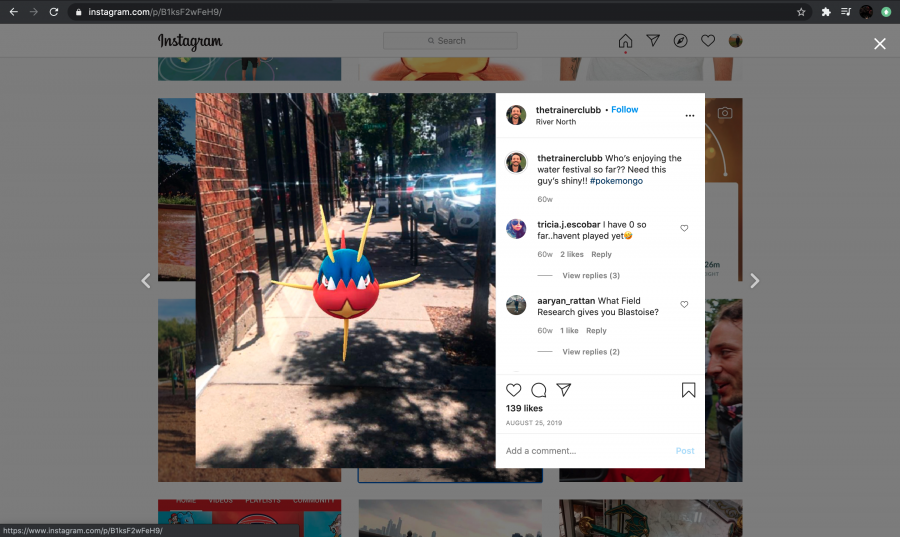
The Trainer Club’s Instagram post on 25/8/2019
Taking this post published on 25 August, 2019 as an example, the Trainer Club positioned Carvanha, a fish-like Pokémon, in the middle of the street with the caption “who’s enjoying the water festival so far?? Need this guy’s shiny!! #pokemongo.”
To offer some context, the post was published during the Water Festival in Pokémon Go, in which the “shiny” form of Carvanha was initially released (see Zeroghan, 2019a). Shinies, or shiny Pokémons, are Pokémons “with different coloration to what is usual for its species” (Bulbapedia, n.d.). Shiny variants are extremely rare as the chance of one stumbling upon one is 1 in 450 (The Sliph Road, 2018). The influencer’s captions here served as an invitation for his fans to share stories regarding their experience with the Water Festival and their progress on the hunt for a shiny Carvanha.
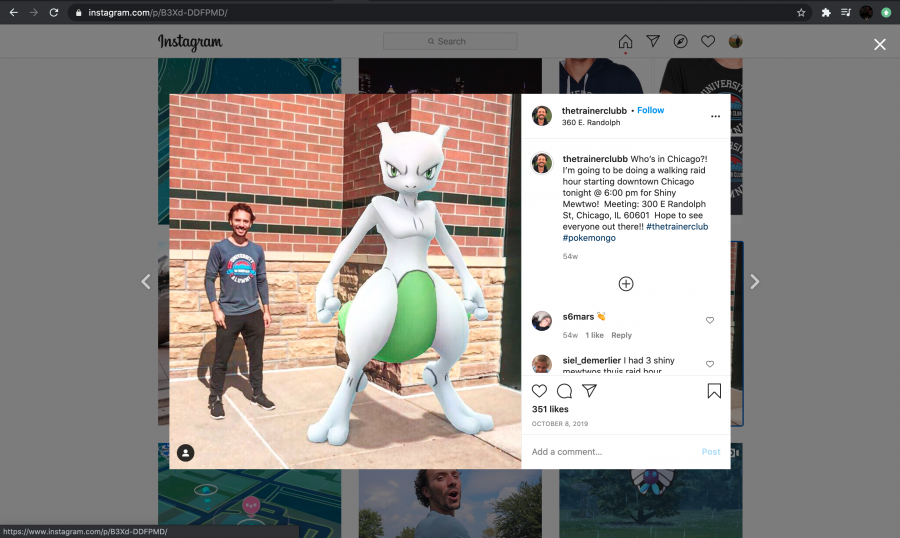
The Trainer Club’s Instagram post on 8/10/2019
Another similar instance can be observed in this post published on 8 October, 2019, the influencer could be seen standing in front of a building alongside a shiny Mewtwo, a coveted legendary Pokémon among fans of the franchise, with the caption:
"Who’s in Chicago?! I’m going to be doing a walking raid hour starting downtown Chicago tonight @ 6:00 pm for Shiny Mewtwo! Meeting: 300 E Randolph St, Chicago, IL 60601 Hope to see everyone out there!! #thetrainerclub #pokemongo" (Trainer Club, 2019).
What is important to note is that an in-game event called “Legendary Raid Hour,"was taking place on the date the post was published ( Zeroghan, 2019b). In this event, players would be able to participate in multiple raids featuring legendary Pokémon as they would appear way more frequently; by publicizing his own location in the caption, the influencer invited his community to join in on the hunt together.
As one can observe, these posts mainly serve as tools for the maintenance of the influencers’ community, that is, through these creative AR photos and welcoming captions, The Trainer Club engages his audience in the hope of fostering his social capital which he needs in order to gain more traction to his brand.
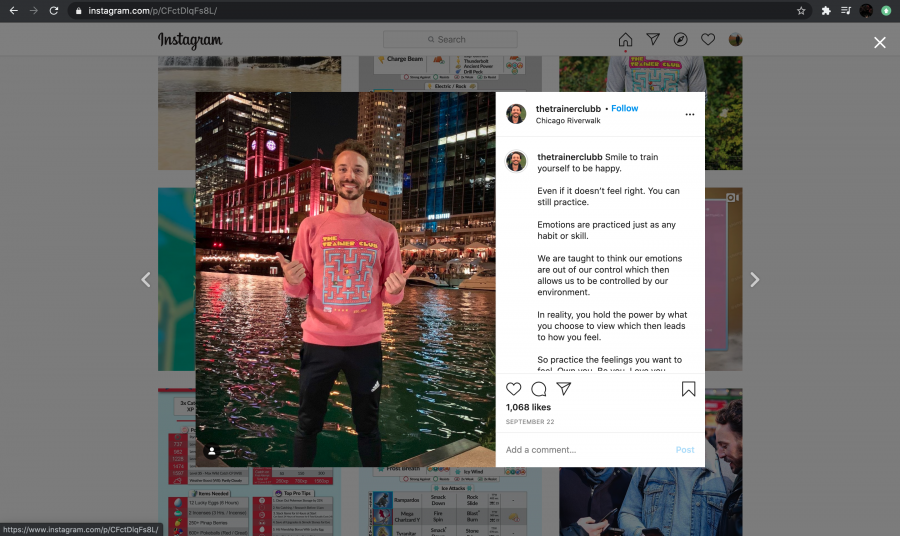
The Trainer Club’s Instagram post on 22/9/2019
As for the posts about the influencer’s personal lives, let us examine this post published on 22 September, 2019. Here the influencer posed in front of the Chicago Riverwalk. To briefly sum up his captions, the Trainer Club urges his audience to “smile to train themselves to be happy," and that they are not only in control of theirown emotions but should not let the environment dictate how they feel. The influencer concluded by three simple imperatives: “Own you. Be you. Love you” (2019).
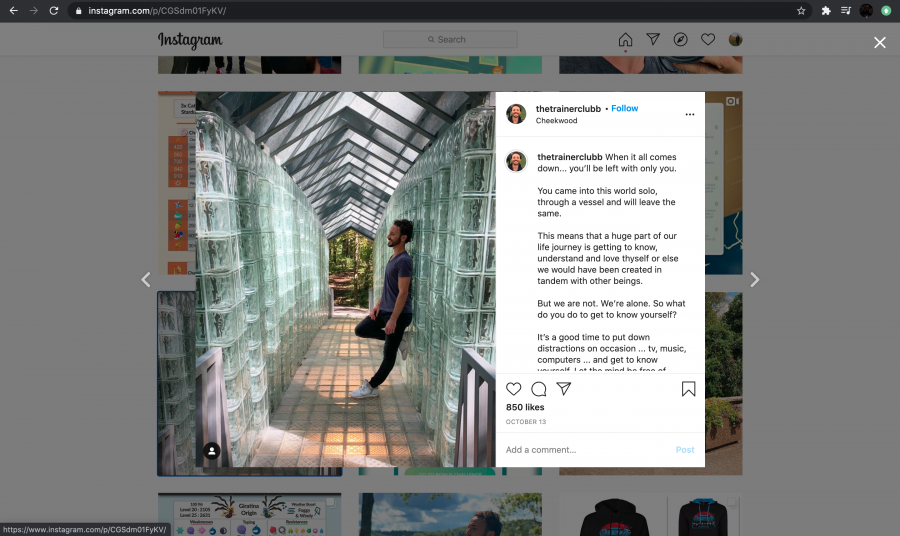
The Trainer Club’s Instagram post on 13/10/2020
Another similar post that somewhat exemplifies his personal content on Instagram was published on 13 October, 2020. In the post, we can see that the influencer was leaning against a glass wall of an archway with a natural smile. In the captions, The Trainer Club began by stating that at the end of the day, “you’ll be left with only you”; as such, a crucial segment of our journey of life is to get to “know, understand, and love thyself” (2019).
The influencer went on to explain how one could achieve such end. In his opinion, in order to get in touch with ourselves, we need to take a step back from the distractions in our lives such as “tv, music, computers." Furthermore, as what serves best for each of us on our path towards self-understanding differs from individual to individual, we need to “respect everyone’s uniqueness and in turn you’ll respect your own." The influencer urged once again that one should care for oneself, and then left his audience with the question: “Do you know you?” (2019).
Considering his own experience with physical/mental health issues (The Trainer Club, 2020), it might be understood that here the influencer has made use of the Instagram platform to raise awareness for self-love and self-understanding. What is also noteworthy is that these posts are seen more frequently in 2020, when he already accumulated a relatively solid fanbase compared to his brand during its infancy in 2018. Similar to Grande’s observation in the bradleysimmonds case (2019, p.45), we can understand the growth of posts about his personal lives in the Trainer Club’s Instagram account as a gradual shift into an emphasis on himself rather than Pokémon Go, which could help the influencer expand his social capital through creating a sense of intimacy between him and his followers.
Trainer Tips
Nicholas (Nick) Oyzon, better known as Trainer Tips, started his channel on YouTube in February 2016. Trainer Tips has been one of the more established influencers that have been there since the release of the mobile game. With 960 thousand subscribers on Youtube, the influencer began by posting videos covering news regarding Pokémon Go and tips and tricks/tutorials that introduce beginners to the franchise; he later went on to post adventure vlogs where he would travel around the world to play Pokémon Go.
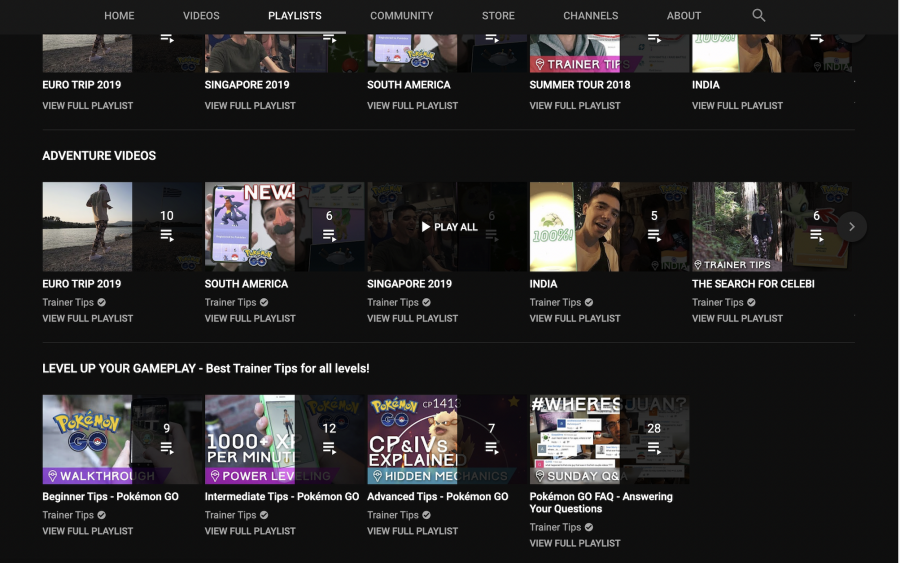
Playlist for tips and tricks videos and adventure vlogs on Trainer Tips’ YouTube channel
For the first category (the posts related to the game or the Pokémon franchise), the most noteworthy thing is that there seems to be an absence of detailed infographics as observed in the case of the Trainer Club. It is not to say that there is an absolute lack of posts regarding the Pokémon franchise however, as we can still similarly spot posts where the influencer utilizes AR photos taken in Pokémon Go to engage his audience.
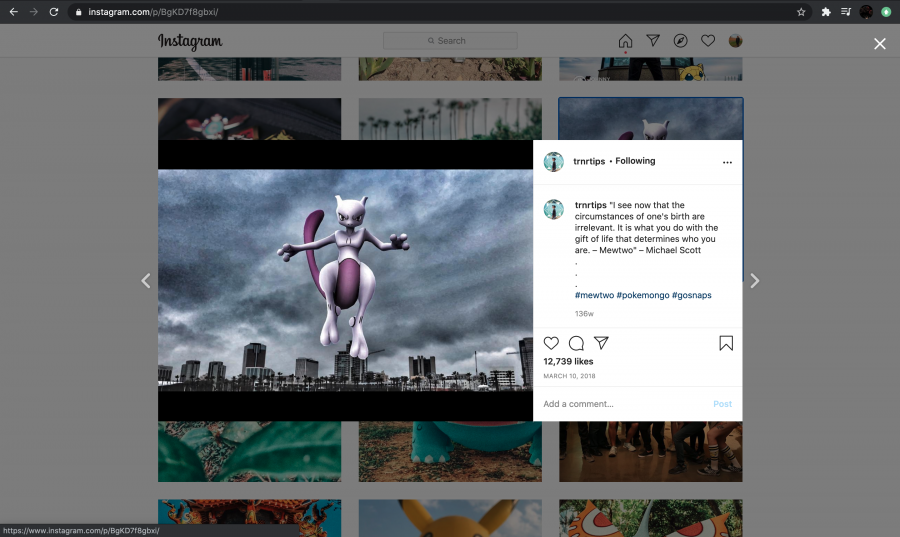
Trainer Tips’ Instagram post on 10/3/2018
Case in point, consider this post published on 10 March, 2018. In the post, we can see Mewtwo, the aforementioned Legendary Pokémon, being placed in the middle of the picture, floating before a cloudy city skyline. The caption of the post read:
"I see now that the circumstances of one's birth are irrelevant. It is what you do with the gift of life that determines who you are. – Mewtwo" – Michael Scott
.
.
.
#mewtwo #pokemongo #gosnaps" (Oyzon, 2018).
While the quote seemed like a run-of-the-mill inspirational quote one would stumble upon on the internet every now and then, it is important to note that this was a quote coming from Mewtwo in the 1998 Pokémon movie Pokémon: The First Movie: Mewtwo Strikes Back ( IMDb, n.d.). Additionally, the influencer was aware that the quote resembles one that is coming from a self-acclaimed inspirational leader; thus after he addressed the quote’s original source (Mewtwo), he also referred to Michael Scott, the fictional boss/inspiring leader wannabe in the NBC television series, The Office. Moreover, unlike the AR photos posted by the Trainer Club, the picture is heavily edited as seen from the overtly-accented shadows on the Pokémon.
As one can observe, on the one hand, in contrast to The Trainer Club, the influencer made use of his noticeable artistry which originated from being an experienced YouTuber to give the AR photo an extra flare. More importantly, it might be contended that in this post, Trainer Tips utilizes his cultural capital of being an established self made YouTuber to create an intriguing photo that would engage his audience. On the other hand, the influencer is using the reference to the original Pokémon movie to show his audiences that he is not simply a Pokémon Go player but more importantly, a passionate fan of the franchise. In other words, by demonstrating his cultural capital as an established YouTuber and an avid Pokémon fan, he could further foster his social capital, i.e., his follower base.
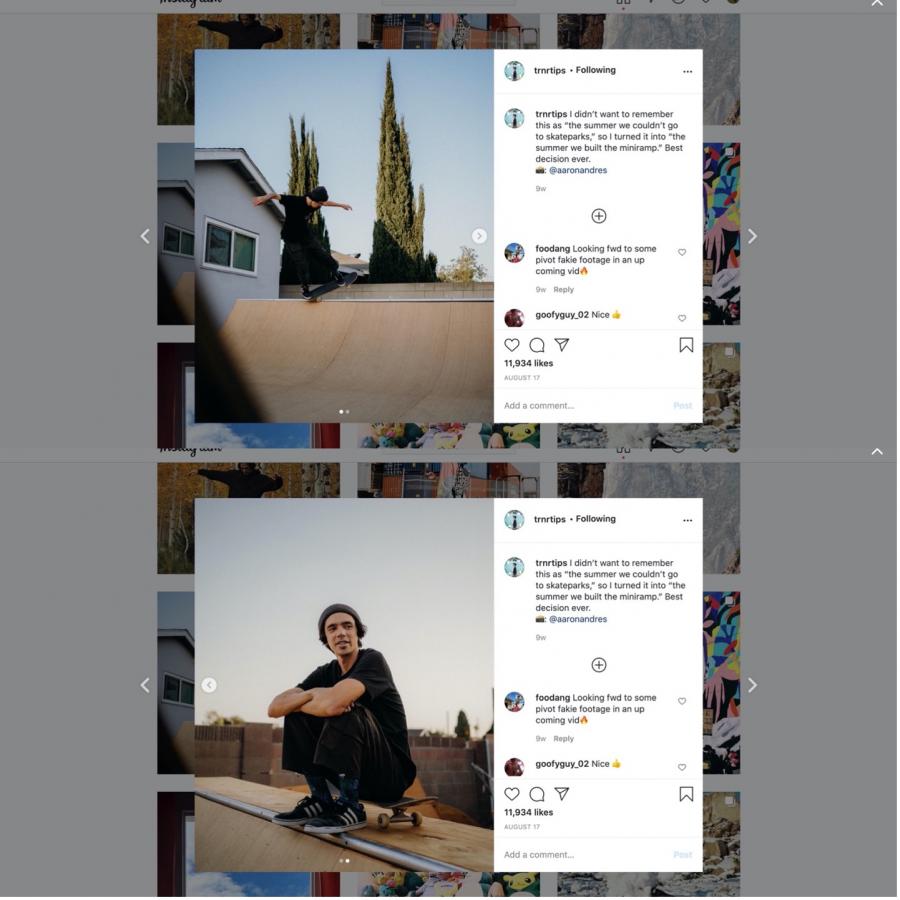
Trainer Tips’ Instagram post on 17/8/2020
The posts about the influencer’s personal lives takes up the majority of Trainer Tips’ posts on Instagram. Let us examine this post published on 17 August, 2020. Two pictures were included in the post. In the first picture, we can see Nick skating on a ramp next to a house; in the second, Nick was seen sitting on a skateboard on the ramp, smiling. Trainer Tips wrote:
"I didn’t want to remember this as 'the summer we couldn’t go to skateparks,' so I turned it into 'the summer we built the miniramp.' Best decision ever
📸: @aaronandres" (Oyzon, 2020).
We can observe another post that is similarly related to the influencer’s personal lives. Published on 8 April, 2020, the post includes a picture presumably taken indoors; outside the window we could see a blue, vibrant sky that was painted with streams of white clouds. This picture is accompanied by a brief text in which the influencer shares his thoughts on the Coronavirus pandemic. To briefly sum up the text, Nick began by stating that he used to shut the blinds in his house since he did not need to see outside when he was in his house. He did not “need to see out, he could just go out”. Yet because of the pandemic lockdown, he could not go out anymore and he began to open the blinds to “let as much of it in as I can."He went on reminiscing about the magnificent outside, which he has taken for granted. While the influencer yearned for the outdoors, he still concluded by urging his followers that we need to stay indoors and abide by the lockdown policy, for “if we work together, we’ll soon be together” (Oyzon, 2020).
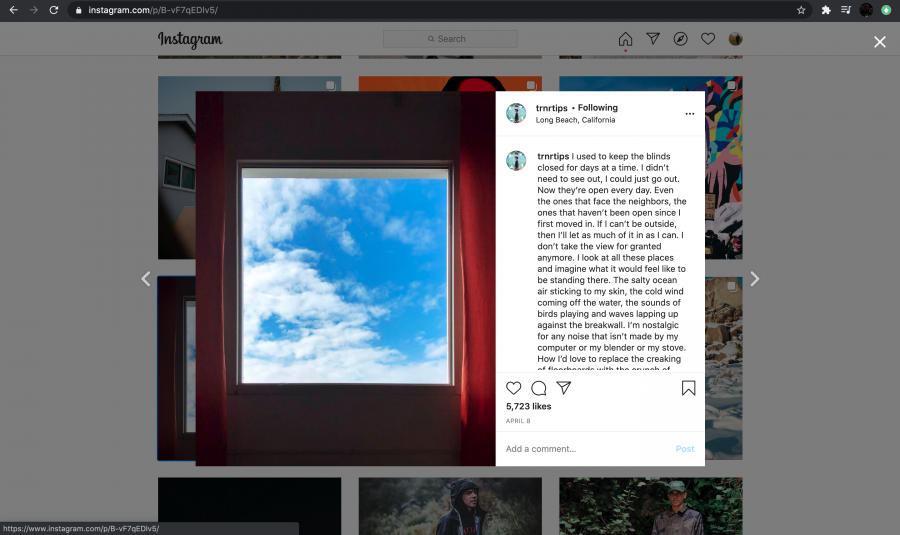
Trainer Tips’ Instagram post on 8/4/2020
As one can observe, these posts function as vivid showcases for the influencer's personal life (during the COVID-19 pandemic). As similarly observed in the case of The Trainer Club, for Trainer Tips, Instagram seems to be a platform where the focus has been put on himself as a micro-celebrity that document his adventures (or the lack thereof during the pandemic lockdown). By publicising these personal adventures and thoughts, the influencer builds a sense of intimate connection between him and his followers, which serve as a way to expand and maintain his social capital.
Gaming and Influencing
This article examined the construction of authenticity for Pokémon Go influencers on Instagram. Through using the Heideggerian framework proposed by Grande (2019), we can see that within the context of Pokémon Go blogging, the formation of an influencers’ authenticity similarly depends on his/her own position within the field. In addition, as one acquires more and more social capital, i.e., followers, there is the tendency for content to start orienting towards the personal, rather than the original gaming discourse. Furthermore, the influencer’s acquired cultural capital, whether that being knowledge on trivias and tidbits in the Pokémon franchise or mastery of gameplay mechanics in Pokémon Go, also shapes his/her authenticity.
As previously explained, past conceptions of authenticity are either grounded in the authentic/inauthentic dichotomy or authenticity as a construct that solely depends on context. This article hopes to illustrate alternative possibilities when it comes to the examination of influencer/micro-celebrity authenticity. In line with Grande (2019), the conception of authenticity as an “ongoing narrative construction” (Varga, Guignon, 2020) regarding an individual’s being in the world offers a middle ground where the exact construction of the notion could be appropriately analyzed.
References
Abdilla, A. (n.d.). Notes for the book Ethics of Authenticity by Charles Taylor.
Abidin, C. (2015). Communicative intimacies: Influencers and perceived connectedness. A Journal of Gender, New Media, & Technology (8).
Abidin, C. (2018). Internet celebrity: Understanding fame online. Bingley: Emerald Publishing.
Bourdieu, P. (1986). The forms of capital. In J. Richardson (Ed.). Handbook of theory and research for the sociology of education. Westport, CT: Greenwood.
Bourdieu, P. (1991). The political ontology of Martin Heidegger, P. Collier (trans.). Stanford, CA: Stanford University Press.
Bruns, I. (2018). ‘Perceived authenticity’ and ‘trust’ in social media driven influencer marketing and their influence on intentions-to-buy of 18-24-year-olds in Ireland. [Master thesis, Dublin Business School, Ireland].
Dreyfus, H.L. (2008). Being and power: Heidegger and Foucault. International journal of philosophical studies, 4 (1), pp.1-16.
Enli, G. (2015). Mediated authenticity: How the media constructs reality. New York, NY: Peter Lang.
Glucksman, M. (2017). The rise of social media influencer marketing on lifestyle branding: A case study of Lucie Fink. Elon Journal of Undergraduate Research in Communications,8 (2), pp. 77-87.
Grande, D. (2019). The power of sets and reps: How fitness bloggers on Instagram construct authenticity. [Master thesis, Lund University, Sweden]. LUP Student Papers.
Heidegger, M. (1962). Being and time, J. Macquarrie & E. Robinson (trans.). New York, NY: Harper & Row.
IMDb. (n.d.). Pokémon: The first movie-Mewtwo strikes back (1998).
Marwick, A.E & boyd, d. (2010). I tweet honestly, I tweet passionately: Twitter users, context collapse, and the imagined audience. New media & society, 13 (1), pp.114-133. DOI: 10.1177/1461444810365313
Perelli, A. (2022). How much money YouTubers make, according to dozens of creators. Insider.
Pöyry, E. I., Pelkonen, M., Naumanen, E. & Laaksonen, S-M., (2019). A call for authenticity: Audience responses to social media influencer endorsements in strategic communication. International Journal of Strategic Communication, 13 (4), pp. 336–351.
Reade, J. (2020). Keeping it raw on the ‘gram: Authenticity, relatability and digital intimacy in fitness cultures on Instagram. New media & society, 00 (0), pp.1-19. DOI: 10.1177/1461444819891699
Routledge. (2016). Habitus: Pierre Bourdieu. Social Theory re-wired.
Senft, T.M. (2008). Camgirls: Celebrity and community in the age of social networks. New York, NY: Peter Lang.
Shiny Pokémon. (n.d.). In Bulbapedia.
Taylor, C. (1991). The ethics of authenticity. Cambridge, MA: Havard University Press
The Silph Road. (2018). The shiny hunt: Honing in on shiny encounter rates.
Varga, S. & Guignon, C. (2020). Authenticity. In E.N. Zalta (Ed.), Stanford Encyclopedia of Philosophy.
Winslow, J. (2019). Pokemon Go surpasses one billion downloads. GameSpot.
Woods, S. (2016). #Sponsored: The emergence of influencer marketing. Chancellor’s Honors Program Projects.
Zeroghan. (2019a). Pokémon Go water festival 2019. Pokémon Go Hub.
Zeroghan. (2019b). Make-up Mewtwo legendary raid hour takes place October 8, 2019. Pokémon Go Hub.